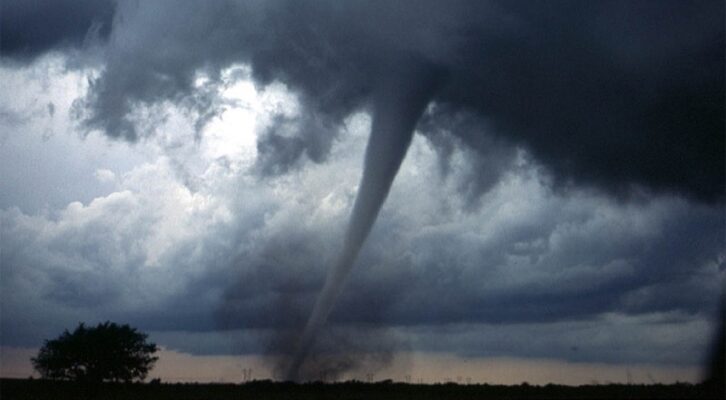
From Breezes to Tornadoes: What Happens When the Wind Turns Deadly?
Simon Winchester Considers the Dramatic Dual Nature of an Essential Element
A robust and lustily blowing gale can be an invigorating happening. Ever since childhood I have listened to the nightly BBC broadcast of the Shipping Forecast, created a century ago for all those vessels—fishing boats, mainly—that were doing their business on great waters, as the psalm has it, out on the seas around the British Isles. Out in the ferocious gales of the North Sea, on the overcrowded routes of the Irish Sea and the English Channel, and off to the islands’ west, the wide Atlantic herself.
Out there, in those so-called sea areas with names that all British radio listeners would come to know intimately—Humber, Dogger, Malin, Viking, Hebrides, Trafalgar, southeast Iceland, Faroes, Finisterre— mariners would listen keenly to the near-poetic intonations of the announcers, telling them of the expected conditions—Rockall, nine hundred and sixty filling slowly to nine hundred and ninety, westerly Storm Force Ten, backing southwest eight, snow showers becoming rain, poor becoming good—which in this case told a fisherman who was riding the gray swells way to the west of Scotland’s Outer Hebrides that a cyclonic depression was easing, the winds were slowing and backing across the compass to bring in warmer southerly air, the snow was changing to rain, and the visibility from the bridge was likely to improve in the coming hours. He would, in short, soon be a happier skipper.
And meanwhile, in common with countless others in bedrooms around the nation—for this broadcast, invariably heard around local midnight, has in recent years become required listening for a sizable fraction of the British public—I would pull the blankets more cozily up to my chin, listen to the rain drumming on the windowpanes, and reflect that at least I wasn’t out in a full gale on the high seas but snug and safe at home. And it was the wind in particular that we always wanted to know about. Not the rain or the fog or the driving snow. What we always wanted was: Was it blowing Force Three or Four—the Beaufort scale we all somehow knew—or was it maybe roaring Six or Eight, with great waves and swells, or maybe even Force Ten or worse, with the tiny trawler, blinded by spume, heeling over in constant danger of foundering and sinking to its doom? That was what made the forecast in a perverse way somehow comforting—the danger was out there, while all here in bed within, though the wind might be doing its worst outside, was secure, as it surely always would be. And so, sleep.
*
Except—not necessarily. Strange and not entirely explicable things are nowadays happening in the world of wind. Gales seem to be blowing where they ought not to, and are ceasing to blow where for centuries past they always have. The word unprecedented seems lately to be more commonly used in weather reports. In the winter of 2025 the hot and dry northeasterly Santa Ana winds did terrible, unprecedented damage, far worse than their habitual seasonal hammering of Los Angeles, when they firmly remind city dwellers of how peculiarly ephemeral life is, of “how close to the edge,” as Joan Didion famously put it, they choose to live.
In 2025 these infamous katabatic winds, rushing down from the desert, were said to have been directly responsible for the spread of an unprecedented cluster of wildfires in Pasadena, Altadena, and Malibu, by far the most destructive, costly, and tragic in the region’s history.
Europe had formidable outbreaks of hurricane-force winds in 2024 and 2025. And then again and somewhat earlier elsewhere, and as a specific illustration of the changing location of violent wind outbreaks, take the events of March 2023, which devastated the hitherto climatically unscathed small town of Rolling Fork, Mississippi. That was a storm of ominous aspect.
Were it not sited astride Route 61, the musically famed “Blues Alley” of the Mississippi Delta, Rolling Fork would be a place of rather limited significance. Fewer than two thousand people, 70 percent black, 30 percent white, and no Native Americans, despite this once having been Choctaw country. It is a county seat and has a city hall, a courtroom, a police station, a school, and a small depot on the Illinois Central line that once took the famous City of New Orleans nightly express down from Chicago to the Gulf. None of these buildings—solid structures that had stood in Rolling Fork for the past century—remain standing today. On March 24 a tornado of exceptional strength blew in from the west, leaped across the Mississippi River ten miles away and zeroed in on this sorry little town, destroying almost all of it in thirty minutes of shattering Friday-night chaos.
What made this melancholy event somewhat unusual was its location—a direct hit by a severe tornado on a town well to the east of the Mississippi River. Such was not exactly unheard of—there have been tornadoes as far east as Massachusetts—but it was sufficiently unexpected as to catch the inhabitants unawares, and also tended to confirm a growing belief among American Midwesterners that the traditional location of Tornado Alley, which runs up the prairies from Texas to Nebraska and is where most such storms occur, was shifting steadily eastward.
The scale of the disaster became starkly apparent to me five months after its occurrence, when I was at a book festival in Jackson, the Mississippi state capital. I had thought to rent a car and go see the damage for myself, since Rolling Fork was only ninety miles away. But it turned out that just about all the volunteers on duty at the festival came from the stricken town—because their homes and businesses had all been wrecked and they had no work, no homes, and nowhere else to stay. One lady, who worked for the Farm Bureau insurance company in Rolling Fork, was more than happy to drive me there and show me around.
Wind is a familiar thing, a thing whose very existence brings a kind of reassurance—yearned-for when absent, delighting when gentle, accursed when either biting cold or parching hot, feared when violent.
She had been in Mexico visiting one of her sons when first she heard the news late on the Friday night. She managed to get a flight by way of Atlanta on Saturday and returned to an utterly devastated hometown that afternoon. Everything was gone. Her home was demolished, as was her office. The family’s forty-year- old Airstream camper was no more than a mess of pulverized metal. The town’s main water tower was down, as was every utility pole. Every government building was wrecked. Two eighteen-wheeler trucks lay upside down on top of a crushed drugstore. Seventeen people had died, and ten times that number were injured.
By the time she reached town the wreckage was already crawling with police and ambulance workers—and insurance adjusters, many from her own company. She was proud to be able to say later on that she issued the first refund check on Tuesday, a scant eighty hours after the tornado struck. Five months on, not much had changed. The Rolling Fork that I saw in August was scarcely recognizable as a place where people might once have lived—it looked like a miniature version of Gaza, only set down among the bayous and paddies of the Delta, the weather torrid and humid, its inclemency kept partly at bay by thousands of roaring generators. She and her husband were initially living in a tiny trailer that had been provided by FEMA, the government agency charged with helping after major disasters.
The trailer had been brought upriver from New Orleans, where it had housed victims of the devastating Hurricane Katrina in 2005. I kept in touch with them; by now they had finally moved out of the trailer, their house sufficiently restored to be habitable. They had lived in town for forty years, but would now, shaken by the event, leave and live out their retirement somewhere more peaceable and secure.
And the thing that troubled her most? The wind. “It was bad enough suffering through a tornado, which we have never once experienced before,” she complained. “But ever since this storm, I feel, the wind has somehow changed. Nowadays there seems to always be something blowing up from the Mississippi River. It never used to be so windy. It rattles the windows. It makes the roof shingles clatter. The washing on the line has to be held extra secure. Things are changing, and I want no more of it. So we’re thinking of leaving, heading off for somewhere the wind don’t blow so hard.”
To students of the phenomenon of changing wind patterns, anecdotal evidence like this proves to be both bothersome and intriguing. For however capricious the wind may be—with its caprices extending within the doldrums to long periods of seeming nonexistence, as well in higher latitudes to episodes of terrifying cyclonic insanity like in Rolling Fork—it has an omnipresence still that offers some kind of comfort. Wind, in its endless train of forms, speeds, directions, and qualities, seems always to be there, always to have been there, eternal and ceaselessly “going on,” as with the beating waves of the seashore. As with life, if you will. Wind is a familiar thing, a thing whose very existence brings a kind of reassurance—yearned-for when absent, delighting when gentle, accursed when either biting cold or parching hot, feared when violent. But familiar nonetheless; an ever-present reminder of the living presence of Nature and of the planet that is so uniquely bathed in its presence.
__________________________________

From The Breath of the Gods: The History and Future of the Wind by Simon Winchester. Copyright © 2025 by Simon Winchester. Published by Harper, an imprint of HarperCollins Publishers. Reprinted by permission.
Simon Winchester
Simon Winchester is the acclaimed author of many books, including The Professor and the Madman, The Men Who United the States, The Map That Changed the World, The Man Who Loved China, A Crack in the Edge of the World, and Krakatoa, all of which were New York Times bestsellers and appeared on numerous best and notable lists. In 2006, Winchester was made an officer of the Order of the British Empire (OBE) by Her Majesty the Queen. He resides in western Massachusetts.



















